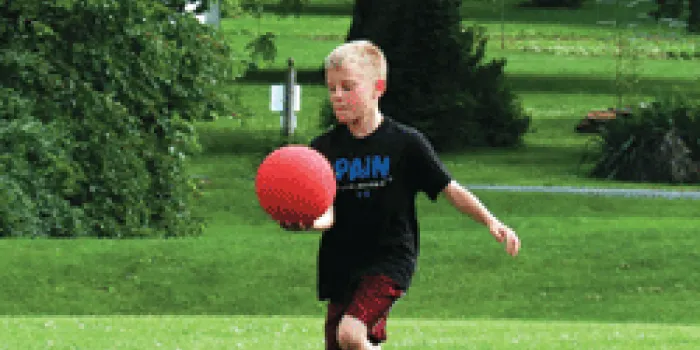Kickball may be a summer camp and schoolyard favorite, but it’s a sport that’s drawing adults, too. Played at recess, in weekend pickup games and in amateur leagues, kickball is easy to learn and play, brings people together and requires no special equipment other than a bouncy red ball. Best of all for folks with bleeding disorders, it offers few risks to spoil the fun.
Dakota Janesky, 9, of Lancaster, Pennsylvania, plays kickball up to 10 times a week, says his mom, Joellyn Janesky. “If he can play at every recess, he will,” she says. Dakota’s severe hemophilia A doesn’t slow him down. “He plays full throttle.”
If you’re not familiar with kickball, imagine baseball without a bat. Players kick a big red ball and try to round three bases and make it to home plate to score without getting tagged out by the other team. Like baseball, players are also out if someone on the other team catches the ball.
Not just child’s play
Kickball is a popular game among adults, too. WAKA Kickball & Social Sports has had leagues in at least 35 states since the organization, initially called the World Adult Kickball Association, was founded in Washington, DC, in 1998. A league typically includes four to 18 teams with about 100 to 470 total players per league, according to WAKA.
Games played by kids at school usually continue until the bell rings, while organized league games typically last a set number of innings.
Healthy adjustments
As fun as kickball is, safe play requires a few caveats for people with bleeding disorders. Players may also need to make adjustments to accommodate those at higher risk of a bleed.
“First, take a good look at the playing field for potholes and other hazards,” says Joel Lee, MPT, a physical therapist with University of Iowa Hospitals and Clinics in Iowa City. “You need a good, safe running space and good-quality athletic shoes.”
Players should use a lightweight ball, rather than a heavier one such as a soccer ball. Lee recommends that adults supervise kids’ game. Everyone involved should agree to rules and modifications prior to the game. “Kids can get so excited during a game that they lose sight of the risks,” Lee says. Talk to your physical therapist about what you need to watch out for when playing kickball. If you have knee or ankle problems, for example, you need a ghost runner to run the bases on your behalf, says Sherry Herman-Hilker, MS, PT, a physical therapist at the University of Michigan’s Hemophilia Treatment Center in Ann Arbor.
At Camp Bold Eagle in Holton, Michigan, run by the Hemophilia Foundation of Michigan (HFM), counselors and camp leaders include all kids who want to play kickball. That often means adjusting the game for players in wheelchairs or on crutches. Camp staff have found fun and creative ways to do that, says camp director Tim Wicks, HFM’s education and youth programs coordinator.
“We’ve gone to thrift stores and bought old wheelchairs so that everybody who ‘bats’ is in a wheelchair, with someone to push them,” says Wicks, 29. “The kids do the best they can, while we modify the game, get their feedback, and then adapt and improve while making sure they have fun.”
Wicks’ campers stretch and warm up before playing any game that involves running. The camp logs very few bleeds from its kickball games, showing that the precautions taken are helpful.
Dakota is prone to spontaneous bleeds in his right knee and injury-induced bleeds in his fingers. So he stays safe by following a few ground rules, says his mom. For example, he never plays catcher, so there’s no worry that a player eager to reach home base will crash into him. Instead, he plays in the outfield, where the risk of full contact is minimal. He treats prophylactically three times a week, and more often if he’s recovering from a bleed. “He knows to play kickball in a controlled environment,” says Janesky. “It helps keep him healthy and socially active.”

